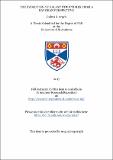The evolution of galaxy structures from a Bayesian perspective
Abstract
Galaxy structures in the local Universe are the result of an evolution spanning billions of years.
The diversity in morphologies observed is due to mechanisms that could either be from external
interactions or internal processes. The hierarchical merging of two massive galaxies has long been
thought to give rise to pressure-supported spherical structures, including elliptical galaxies and classical bulges. On the other hand, isolated galaxies may evolve at a much slower pace with the accretion of gas forming flattened rotationally-supported discs. Secular evolution could also result in newly formed internal structures, such as bars or discy-bulges. The first step in understanding the complex pathways that formed these monolithic beasts, we need to robustly measure their structures.
This thesis investigates how the structure of galaxies have evolved over the last seven Gyrs. In
the first part I present a new Bayesian Markov Chain Monte Carlo (MCMC) two-dimensional (2D)
photometric decompositions algorithm called PHI. The purpose of the algorithm is to decompose a
galaxy’s light profile into the various components that make-up the structure. By implementing a
three level method, PHI is able to obtain a full understanding of the parameter space overcoming
many of the major issues previous codes have struggled with.
The second part of the thesis describes the generation of synthetic galaxy images which are used
to test the robustness of PHIand to also highlight the cosmological and instrumental effects that may
bias the outcomes. We also present is a performance test for the Bayesian application to bulge-disc
decompositions of galaxies using images from the Sloan Digital Sky Survey (SDSS), also included is
the parameter estimation and model comparison method using the Bayesian Information Criteria.
In the third part of this thesis we show how the use of Hierarchical Bayesian Models (HBM)
can be used to describe structural scaling relations in the local Universe. A constant piece-wise
representation fully captures the underlying nature of the sample. This leads to the analysis of
many structural scaling relations, one being the positive trend between the effective radius of the
bulge and the Sérsic index.
Lastly, a study investigating the structural evolution of galaxies within the COSMOS field in the
redshift range 0.5 < z < 1.25 is presented. The flexible nature of the HBM allows for a detailed
description of the build-up of galaxy structures in the local Universe.
Type
Thesis, PhD Doctor of Philosophy
Collections
Items in the St Andrews Research Repository are protected by copyright, with all rights reserved, unless otherwise indicated.

